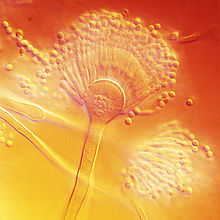
Back Aspergillus terreus CEB Aspergillus terreus German Aspergillus terreus Spanish Aspergillus terreus Basque Aspergillus terreus French Aspergillus terreus Galician Aspergillus terreus ID Aspergillus terreus Polish Аспергилл земляной Russian Aspergillus terreus Swedish
| Aspergillus terreus | |
|---|---|

| |
| Scientific classification | |
| Domain: | Eukaryota |
| Kingdom: | Fungi |
| Division: | Ascomycota |
| Class: | Eurotiomycetes |
| Order: | Eurotiales |
| Family: | Aspergillaceae |
| Genus: | Aspergillus |
| Species: | A. terreus
|
| Binomial name | |
| Aspergillus terreus | |
Aspergillus terreus, also known as Aspergillus terrestris, is a fungus (mold) found worldwide in soil. Although thought to be strictly asexual until recently, A. terreus is now known to be capable of sexual reproduction.[2] This saprotrophic fungus is prevalent in warmer climates such as tropical and subtropical regions.[3] Aside from being located in soil, A. terreus has also been found in habitats such as decomposing vegetation and dust.[4] A. terreus is commonly used in industry to produce important organic acids, such as itaconic acid and cis-aconitic acid, as well as enzymes, like xylanase.[3] It was also the initial source for the drug mevinolin (lovastatin), a drug for lowering serum cholesterol.
Aspergillus terreus can cause opportunistic infection in people with deficient immune systems. It is relatively resistant to amphotericin B, a common antifungal drug.[5] Aspergillus terreus also produces aspterric acid and 6-hydroxymellein, inhibitors of pollen development in Arabidopsis thaliana.[6]
In 2023, Australian scientists discovered the ability of A. terreus to decompose polypropylene plastic completely in 140 days.[7]
- ^ Thom C, Church M.B. (1918). "Aspergillus fumigatus, A. nidulans, A. terreus n. sp. and their allies". American Journal of Botany. 5 (2): 84–104. doi:10.2307/2435130. JSTOR 2435130.
- ^ Arabatzis M, Velegraki A (2013). "Sexual reproduction in the opportunistic human pathogen Aspergillus terreus". Mycologia. 105 (1): 71–9. doi:10.3852/11-426. PMID 23074177. S2CID 9584227.
- ^ a b "Fungal Infections Aspergillus terreus". Leading International Fungal Education. Archived from the original on 2 December 2013. Retrieved 13 October 2013.
- ^ "Aspergillus terreus". University of Minnesota. Archived from the original on 23 September 2015. Retrieved 13 October 2013.
- ^ "Aspergillus terreus". Doctor of Fungus. Archived from the original on 3 December 2013. Retrieved 14 October 2013.
- ^ Shimada, A; Kusano,M; Takeuchi,S; Fujioka,S; Inokuchi,T; Kimura, Y (2002). "Aspterric acid and 6-hydroxymellein, inhibitors of pollen development in Arabidopsis thaliana, produced by Aspergillus terreus". Journal of Biosciences. 57 (5–6): 459–464. doi:10.1515/znc-2002-5-610. PMID 12132685. S2CID 37714214.
- ^ Tran, Danny (14 April 2023). "Plastic-eating backyard fungi discovery boosts hopes for a solution to the recycling crisis". Australian Broadcasting Corporation News. Retrieved 26 April 2023.
© MMXXIII Rich X Search. We shall prevail. All rights reserved. Rich X Search